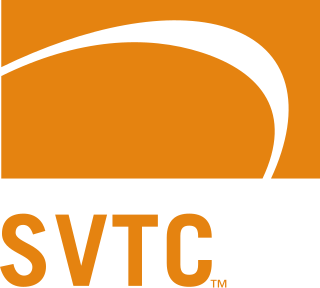Related Research Articles

STMicroelectronics N.V. commonly referred to as ST or STMicro is a Dutch multinational corporation and technology company of French-Italian origin headquartered in Plan-les-Ouates near Geneva, Switzerland and listed on the French stock market. ST is the largest European semiconductor contract manufacturing and design company. The company resulted from the merger of two government-owned semiconductor companies in 1987: Thomson Semiconducteurs of France and SGS Microelettronica of Italy.

Cypress Semiconductor was an American semiconductor design and manufacturing company. It offered NOR flash memories, F-RAM and SRAM Traveo microcontrollers, PSoC programmable system-on-chip solutions, analog and PMIC Power Management ICs, CapSense capacitive touch-sensing controllers, Wireless BLE Bluetooth Low-Energy and USB connectivity solutions.

SEMATECH is a not-for-profit consortium that performs research and development to advance chip manufacturing. SEMATECH has broad engagement with various sectors of the R&D community, including chipmakers, equipment and material suppliers, universities, research institutes, and government partners. The group is funded by member dues.
KLA Corporation is an American capital equipment company based in Milpitas, California. It supplies process control and yield management systems for the semiconductor industry and other related nanoelectronics industries. The company's products and services are intended for all phases of wafer, reticle, integrated circuit (IC) and packaging production, from research and development to final volume manufacturing.


Interuniversity Microelectronics Centre (IMEC) is an international research & development organization, active in the fields of nanoelectronics and digital technologies, with headquarters in Belgium. Luc Van den hove has served as President and CEO since 2009.

In the microelectronics industry, a semiconductor fabrication plant is a factory for semiconductor device fabrication.
Nanoelectronics refers to the use of nanotechnology in electronic components. The term covers a diverse set of devices and materials, with the common characteristic that they are so small that inter-atomic interactions and quantum mechanical properties need to be studied extensively. Some of these candidates include: hybrid molecular/semiconductor electronics, one-dimensional nanotubes/nanowires or advanced molecular electronics.
The IEEE Robert N. Noyce Medal is a science award presented by the IEEE for outstanding contributions to the microelectronics industry. It is given to individuals who have demonstrated contributions in multiple areas including technology development, business development, industry leadership, development of technology policy, and standards development. The medal is named in honour of Robert N. Noyce, the co-founder of Intel Corporation. He was also renowned for his 1959 invention of the integrated circuit. The medal is funded by Intel Corporation and was first awarded in 2000.
The College of Nanoscale Science and Engineering is the college of nanotechnology at the SUNY Polytechnic Institute campus in Albany, New York. Founded in 2004 at the University at Albany, SUNY, the college underwent rapid expansion in the late-2000s and early-2010s before merging with the SUNY Institute of Technology in 2014. The college will rejoin the University at Albany in 2023. The college was the first college in the United States devoted to nanotechnology.
The Western Institute of Nanoelectronics WIN is a research institute founded in 2006 and has its headquarters at the UCLA Henry Samueli School of Engineering and Applied Science in Los Angeles, California, US. The WIN Center networks multiple universities with the Industry and government based sponsors and the National Institute of Standards and Technology (NIST) in pursuit of replacing Complementary Metal-Oxide Semiconductor Field-Effect Transistors. WIN's research is focused on spintronics extending from materials, devices, and device interactions, metrology and circuits/architectures. Sponsors include:
GlobalFoundries Inc. (GF) is a multinational semiconductor contract manufacturing and design company incorporated in the Cayman Islands and headquartered in Malta, New York. Created by the divestiture of the manufacturing arm of AMD, the company was privately owned by Mubadala Investment Company, the sovereign wealth fund of the United Arab Emirates, until an initial public offering (IPO) in October 2021.

Tech Valley began as a marketing name for the eastern part of the U.S. state of New York, encompassing the Capital District and the Hudson Valley. Originating in 1998 to promote the greater Albany area as a high-tech competitor to regions such as Silicon Valley and Boston, the moniker subsequently grew to represent the counties in New York between IBM's Westchester County plants in the south and the Canada–United States border to the north, and has since evolved to constitute both the technologically oriented metonym and the geographic territory comprising most of New York State north of New York City. The area's high technology ecosystem is supported by technologically focused academic institutions including Rensselaer Polytechnic Institute and the State University of New York Polytechnic Institute.
Semiconductor consolidation is the trend of semiconductor companies collaborating in order to come to a practical synergy with the goal of being able to operate in a business model that can sustain profitability.

CEA-Leti is a research institute for electronics and information technologies, based in Grenoble, France. It is one of the world's largest organizations for applied research in microelectronics and nanotechnology.

LSI Logic Corporation, an American company founded in Santa Clara, California, was a pioneer in the ASIC and EDA industries. It evolved over time to design and sell semiconductors and software that accelerated storage and networking in data centers, mobile networks and client computing.

SVTC Technologies was a technology services company that provided development and commercialization services for semiconductor process-based technologies and products. SVTC operated from 2004 to October 2012.
The IEEE International Electron Devices Meeting (IEDM) is an annual micro- and nanoelectronics conference held each December that serves as a forum for reporting technological breakthroughs in the areas of semiconductor and related device technologies, design, manufacturing, physics, modeling and circuit-device interaction.

Dr. Gary Patton is an American technologist and business executive. He is currently the Corporate Vice President and General Manager of Design Enablement and Components Research in the Technology Development Group at Intel. He has spent most of his career in IBM, starting in IBM's Research Division and holding management and executive positions in IBM's Microelectronics Division in Technology Development, Design Enablement, Manufacturing, and Business Line Management.

The CHIPS and Science Act is a U.S. federal statute enacted by the 117th United States Congress and signed into law by President Joe Biden on August 9, 2022. The act provides roughly $280 billion in new funding to boost domestic research and manufacturing of semiconductors in the United States. The act includes $39 billion in subsidies for chip manufacturing on US soil along with 25% investment tax credits for costs of manufacturing equipment, and $13 billion for semiconductor research and workforce training, with the primary aim of countering China.
References
- ↑ ATDF Management: Dave Anderson, General Manager ATDF Archived June 9, 2007, at the Wayback Machine
- ↑ "ATDF & ACC Seeking Summer Interns for Innovative Nanoscholars Program. Archived 2010-08-20 at the Wayback Machine "
- ↑ "Nanopattern Award Press Release [ permanent dead link ]
- ↑ "SEMATECH to sell chip facility Archived 2007-12-05 at the Wayback Machine " from Austin American Statesman